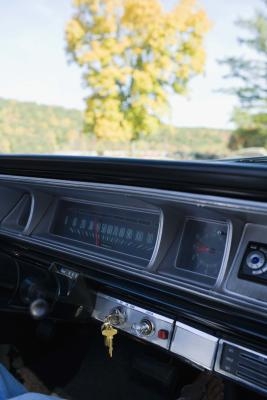
Power inverters come in handy when applied to automobile batteries for another source of AC power. The inverter changes battery DC power into AC current, so that extra appliances and electrical systems can feed off the battery for normal usage requirements, or during emergency situations. Inverters come in handy for camping and trailer life, when voltage must be used to run extra components and systems. Inverters come in various sizes and wattage requirements. To install an inverter in a battery system, the installer must know its demands and limitations.
Place the vehicle in park or neutral, depending upon automatic or manual transmission. Raise the hood and use a socket and wrench to disconnect the negative battery cable. Open the inverter package and read the directions. If you have an inverter with a wattage demand of less than 400 watts and you intend to use small appliances with minimum draw, position your inverter inside the passenger cabin of the vehicle.
Place the inverter in the glove box, and drill a hole in the glove box casing to run the cigarette lighter adapter wire through the hole and connect it with the cigarette lighter, if you wish. Connect the power cord to the back of the inverter and run the cord through the same hole, down under the dash to a convenient location where you can plug into it. Plug the cigarette lighter adapter into the cigarette lighter's port.
Use a drill motor to drill mounting holes under the dash panel or floor board to mount the inverter permanently. Use the self-tapping screws to mount the inverter, tightening them with a screwdriver. Tuck the outlet power wire up under the dashboard, so you know where to retrieve it for plug-in use.
Determine if your power needs require 500 to 700 watts. Turn the inverter to the "Off" position and hook up the negative battery spring clamp supplied with the inverter to the negative post of the battery. Run that wire through a firewall grommet to the chosen location of your inverter and plug it into the inverter.
Hook up the positive spring clamp supplied with the inverter and run it through the firewall and into the plug receptacle of the inverter. Position your power outlet wire in a convenient location, so you can plug into it easily.
Read your instructions to determine if your inverter is rated at 1,500 watts or more. You must use the large "number 4" or "number 2" power supply wires. The distance from the inverter to the battery should not exceed four feet. For this installation, drill mounting holes in your firewall or fender side panel, in a location close to the battery. Use a screwdriver to tighten the self-tapping kit screws to secure the inverter case to the metal.
Turn the inverter "Off," and connect negative inverter cable to the negative terminal on the battery by securing the cable eyelet to the battery clamp bolt. Tighten the bolt with a socket. Reconnect the negative battery cable with a socket. Connect the positive inverter cable to the positive side of the battery in the same fashion. The inverter must be hard-wired directly to the battery in this fashion. Turn the inverter switch to "On" and test an appliance.